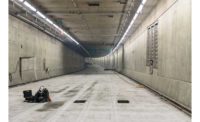The nearly $3.3-billion Alaskan Way Viaduct Replacement Project is set to finish this year, potentially, after crews overcame a saga of challenges and delays. The Washington State Dept. of Transportation project—best known for the 57.5-ft-dia boring machine Bertha and its nearly two-year underground hiatus after overheating just 11% of the way through excavation—is in the final stages.
Upon finishing 1.7 miles of tunneling in April 2017, a $1.4-billion portion of the project, Bertha was taken out piece by piece from the northern end via crane. The last of the 6,850 tons of metal sent to recycling was picked out August 2017.
In March, crews from Seattle Tunnel Partners, a joint venture between Dragados USA and Tutor Perini Corp., finished placing 1,152 panels for the tunnel’s double-deck roadway.
“Seattle Tunnel Partners’ biggest challenge moving forward is making sure that all operational and safety systems work as designed,” says Brian Nielsen, WSDOT project administrator. Once that work is complete, WSDOT will close State Route 99 through Seattle for three weeks, including the elevated Alaskan Way Viaduct this project replaces, to allow Scarsella Brothers Inc. to finish realigning SR 99 in a separate SR 99 Connections Project.
Planning for that project began before the three-week window because of the coordination and sequencing that must happen, says Patrick Fuller, WSDOT project engineer. “We are coordinating with nearby projects and our partner agencies so that the work that needs to happen during the closure is as efficient as possible,” he says.
In addition to the full closure, Nielsen expects an additional two weeks of work to finish ramps, impacting traffic in downtown Seattle for up to five weeks.
Bertha’s woes started in late 2013, requiring a replacement of its main bearing while still underground. Ever since Bertha started tunneling again in February 2016, the project has run smoothly construction-wise. However, on the legal side, lawsuits continue regarding cost overruns of the delay and fix.
STP says it plans to have the tunnel ready for operation in mid-August. WSDOT cautions that the tunnel won’t open until ready, following three levels of testing on the internal systems. WSDOT says the best-case scenario has the tunnel opening in fall, still ahead of the most recent early 2019 planned opening.
The tunnel includes 16 electrical rooms spaced along the alignment to control the lights, cameras and operation of 9,270 ft of electrical, mechanical and plumbing. Within that are 95 miles of wiring, 21 miles of sprinkler pipes, 15 miles of lights, 13 miles of fiber-optic cables and eight miles of heat detectors as part of the fire suppression system that includes 100 safety zones.
Some 300 panning cameras will monitor traffic while electronic sensors sample the air every few seconds. When an uptick in emissions is detected, they will activate jet fans to pull in fresh air. If needed, suctioning exhaust fans will pull air through louvers on the wall into the ventilation corridor and out stacks.





